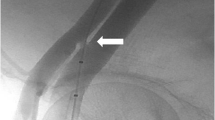Abstract
Excess blood pressure remains the most important risk factor for cardiovascular and renal disease. Poly pharmacy has been proved safe and effective under clinical trial circumstances; however, the majority of patients fail to sustain pharmaceutical persistence and adherence. The opportunity to offer patients a treatment or device in addition or perhaps instead of drug therapy alone may significantly broaden the options for patients and allow greater success in hypertensive therapy. In this review, we examine the potential of a fixed-volume central arterial-venous anastomosis to reduce blood pressure in hypertensive patients, review possible mechanisms by which the anastomosis may reduce blood pressure, and consider the unique clinical trial opportunities posed by this therapy.


Similar content being viewed by others
References
Papers of particular interest, published recently, have been highlighted as: • Of importance •• Of major importance
Kearney PM et al. Global burden of hypertension: analysis of worldwide data. Lancet. 2005;365(9455):217–23.
Chobanian AV et al. Seventh report of the Joint National Committee on Prevention, Detection, Evaluation, and Treatment of High Blood Pressure. Hypertension. 2003;42(6):1206–52.
Naderi SH, Bestwick JP, Wald DS. Adherence to drugs that prevent cardiovascular disease: meta-analysis on 376,162 patients. Am J Med. 2012;125(9):882–7 e1.
Calhoun DA et al. Resistant hypertension: diagnosis, evaluation, and treatment: a scientific statement from the American Heart Association Professional Education Committee of the Council for High Blood Pressure Research. Circulation. 2008;117(25):e510–26.
Wang TJ, Vasan RS. Epidemiology of uncontrolled hypertension in the United States. Circulation. 2005;112(11):1651–62.
Krum H et al. Catheter-based renal sympathetic denervation for resistant hypertension: a multicentre safety and proof-of-principle cohort study. Lancet. 2009;373(9671):1275–81.
Faul JL et al. An arteriovenous fistula increases exercise capacity in patients with COPD. Chest. 2010;138(1):52–8. In this trial an artifiacially created arterio-venous fistula resulted in increased cardiac output, left ventricular stroke work and pulmonary vascular resistance in patients with severe COPD. The 6-minute walk distance was also significantly improved.
Pinto-Plata VM et al. The 6-min walk distance: change over time and value as a predictor of survival in severe COPD. Eur Respir J. 2004;23(1):28–33.
Bertog SC et al. Percutaneous femoral arteriovenous shunt creation for advanced chronic obstructive pulmonary disease: a single-center safety and efficacy study. Circ Cardiovasc Interv. 2012;5(1):118–26.
Burchell AE, et al. Arteriovenous anastomosis: is this the way to control hypertension? Hypertension. 2014;64(1):6–12.
Rose DA, Sonaike E, Hughes K. Hemodialysis access. Surg Clin N Am. 2013;93(4):997–1012. x.
Roy-Chaudhury P et al. Biology of arteriovenous fistula failure. J Nephrol. 2007;20(2):150–63.
Moua T, Wood K. COPD and PE: a clinical dilemma. Int J Chron Obstruct Pulmon Dis. 2008;3(2):277–84.
Fraisse F et al. Nadroparin in the prevention of deep vein thrombosis in acute decompensated COPD. The Association of Non-University Affiliated Intensive Care Specialist Physicians of France. Am J Respir Crit Care Med. 2000;161(4 Pt 1):1109–14.
MacRae JM et al. Arteriovenous fistula-associated high-output cardiac failure: a review of mechanisms. Am J Kidney Dis. 2004;43(5):e17–22.
Malik J et al. Mechanisms of chronic heart failure development in end-stage renal disease patients on chronic hemodialysis. Physiol Res. 2009;58(5):613–21.
Ori Y et al. Haemodialysis arteriovenous access—a prospective haemodynamic evaluation. Nephrol Dial Transplant. 1996;11(1):94–7.
De Lima JJ et al. Cardiac effects of persistent hemodialysis arteriovenous access in recipients of renal allograft. Cardiology. 1999;92(4):236–9.
Gorgulu N et al. Effects of arteriovenous fistula on clinical, laboratory and echocardiographic findings in renal allograft recipients. Int J Artif Organs. 2011;34(10):1024–30.
Kosmadakis G et al. Pulmonary hypertension in dialysis patients. Ren Fail. 2013;35(4):514–20.
Korsheed S et al. Effects of arteriovenous fistula formation on arterial stiffness and cardiovascular performance and function. Nephrol Dial Transplant. 2011;26(10):3296–302. This is the first prospective study to demonstrate the hemodynamic effects of fistula formation on arterial stiffness and cardiovascular performance and function in a large cohort of patients.
Holman E. Abnormal arteriovenous communications. Great variability of effects with particular reference to delayed development of cardiac failure. Circulation. 1965;32(6):1001–9.
McBryde FD et al. The carotid body as a putative therapeutic target for the treatment of neurogenic hypertension. Nat Commun. 2013;4:2395.
Paton JF et al. The carotid body as a therapeutic target for the treatment of sympathetically mediated diseases. Hypertension. 2013;61(1):5–13.
Ashton N et al. Mechanisms involved in the activation of ischemically sensitive, afferent renal nerve mediated reflex increases in hind-limb vascular resistance in the anesthetized rabbit. Can J Physiol Pharmacol. 1994;72(6):637–43.
Winternitz SR, Oparil S. Importance of the renal nerves in the pathogenesis of experimental hypertension. Hypertension. 1982;4(5 Pt 2):III108–14.
Schlaich MP et al. Targeting the sympathetic nervous system: critical issues in patient selection, efficacy, and safety of renal denervation. Hypertension. 2014;63(3):426–32.
Paton JF et al. Revelations about carotid body function through its pathological role in resistant hypertension. Curr Hypertens Rep. 2013;15(4):273–80.
Iwashima Y et al. Effects of the creation of arteriovenous fistula for hemodialysis on cardiac function and natriuretic peptide levels in CRF. Am J Kidney Dis. 2002;40(5):974–82.
Hainsworth R. Cardiovascular control from cardiac and pulmonary vascular receptors. Exp Physiol. 2014;99(2):312–9.
Guyton AC, Sagawa K. Compensations of cardiac output and other circulatory functions in areflex dogs with large A-V fistulas. Am J Physiol. 1961;200:1157–63.
Compliance with Ethics Guidelines
Conflict of Interest
Alice Stanton, Eamon Dolan, and Henry Krum declare no conflict of interest. Marat Fudim is a consultant for Cibiem, Inc. Paul A. Sobotka is a consultant for Abbott Ventures, Ardian, Boston Scientific, Medtronic, Nephera, and Ardelyx and is Chief Medical Officer for Cibiem and Rox Medical.
Human and Animal Rights and Informed Consent
This article does not contain any studies with human or animal subjects performed by any of the authors.
Author information
Authors and Affiliations
Corresponding author
Additional information
This article is part of the Topical Collection on Device-Based Approaches for Hypertension
Rights and permissions
About this article
Cite this article
Fudim, M., Stanton, A., Sobotka, P.A. et al. The Thrill of Success: Central Arterial-Venous Anastomosis for Hypertension. Curr Hypertens Rep 16, 497 (2014). https://doi.org/10.1007/s11906-014-0497-x
Published:
DOI: https://doi.org/10.1007/s11906-014-0497-x




